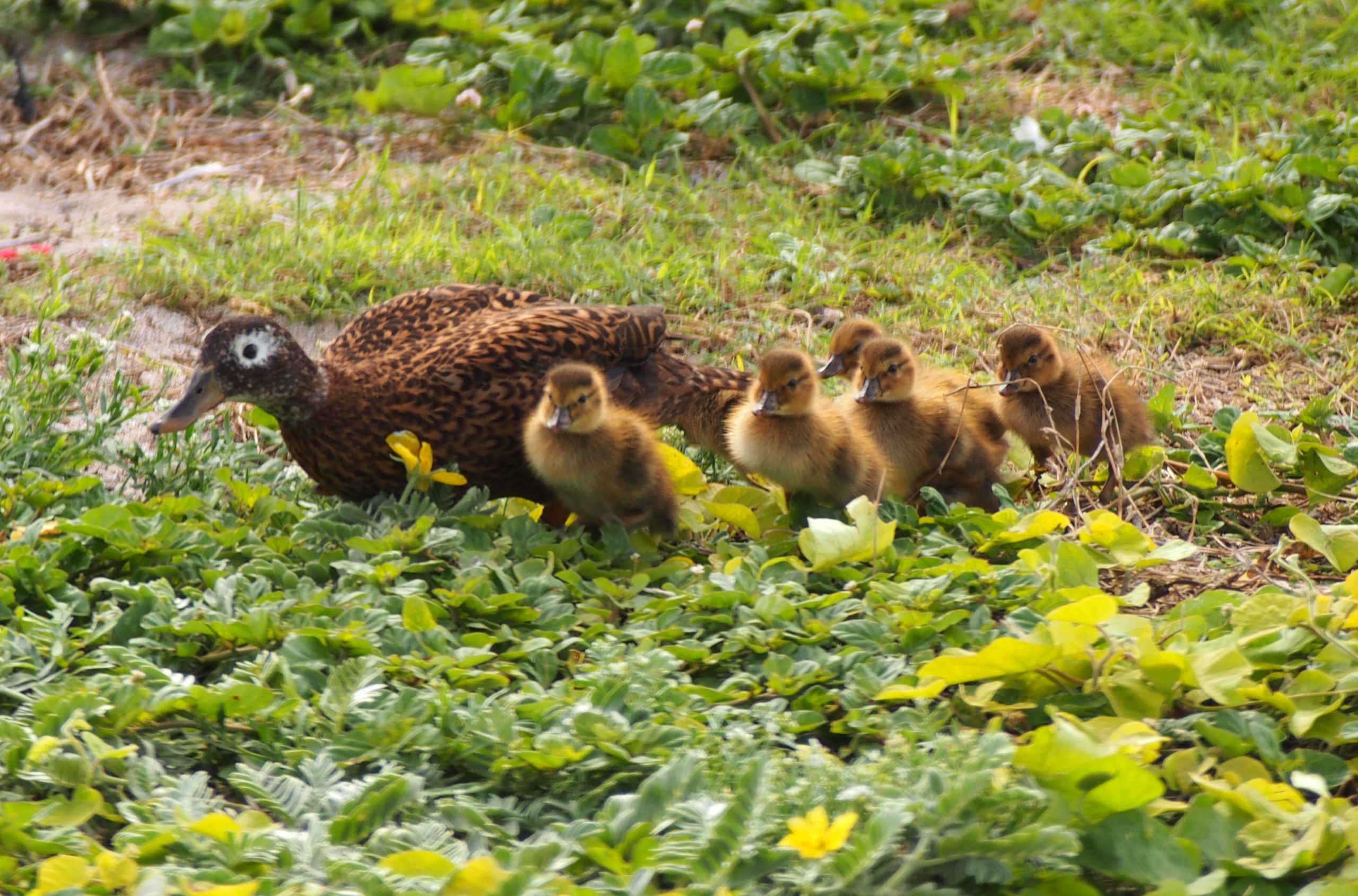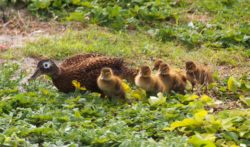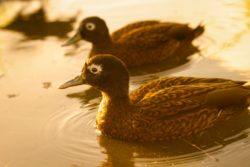
Sea Wonder: Laysan Duck

Photo: Naomi Worchester/Hawaii DLNR
The endangered Laysan duck (Anas laysanensis) is the rarest duck in the northern hemisphere, and it has the smallest geographic range. Fossil records show these ducks once lived throughout the Hawaiian Islands but now live on Laysan Island and two atolls only. Already in decline by the late 1800s, experts believe the Laysan duck nearly went extinct in the early 1900s after rabbits were introduced to the islands. As a result of conservation and management efforts, the Laysan duck made a recovery but remains critically endangered throughout its limited range.
Description
Laysan ducks have brown feathers with beautiful and bright green-blue speculum feathers – secondary feathers along both wings. Around their small eyes are white patches and short, spatula-shaped bills extend from their heads. When fully grown, adults can reach average lengths of 17 inches and weigh just short of a pound. While similar in size, we can distinguish males and females by their bill color – males have an olive-green bill with black markings along its upper half while females have a pale orange bill – and their legs – males having more brightly colored orange legs than females.
Diet & Habitat
Laysan ducks are known as dabbling ducks, which is a classification given based on their feeding strategy. Dabbling ducks generally feed at the water’s surface or dunk their heads into the water for a brief time rather than diving deep. Mallard ducks are another example of dabbling duck.
While they live near the ocean, Laysan ducks have a diet primarily composed of insects and sometimes plants. To catch insects, they duck and run along the salty mudflats of the shore, creating swarms of flies and other insects, which they then catch by rapidly opening and closing their bills like a bird version of Pacman. If feeding in the water, they filter feed to catch zooplankton, algae, floating seeds, and other plant matter. They can forage independently but are commonly found in groups, mostly for protection against potential predators, which include larger frigatebirds and mammals – many of which are non-native – like rats, pigs, and mongooses.
Laysan ducks live on Laysan Island and two atolls in the Northwestern Hawaiian Islands. They rely on two distinct area on their island homes: vegetated uplands and wetlands. Uplands support vegetation needed for their shelter and nesting habitats while wetlands are their foraging habitats. They spend most of their time on land but do make their way to the water to feed. They have the ability to fly but rarely do so and cannot sustain flight for very long. Recently, biologists transferred a group of 28 ducks from Midway Atoll National Wildlife Refuge to Kure Atoll Wildlife Sanctuary – both within Papahānaumokuākea Marine National Monument – to help the species recover and expand its range.
Life History
Laysan ducks can live as long as 12 years, with some individuals in human care reaching 18. This species is behaviorally and genetically distinct from continental duck species given its long lifespan and low reproductive rates. Mallard ducks lay 8 eggs per clutch while Laysan ducks lay an average of 3.8. Their low reproductive rate paired with human development in the 1860s and the introduction of non-native mammalian species like rabbits to the Hawaiian Islands brought their population down to less than 12 individuals by 1912.
Laysan ducks are generally nocturnal feeders and spend most of their time resting in groups on land. These ducks molt in the late summer between July and September, which coincides with their nesting and brooding season. Reproduction occurs on land in the late fall and winter and females begin laying eggs in their well-hidden nests between April and August, with the eggs hatching about four weeks later.
Laysan ducklings are born with their eyes open and covered with yellow-brown down feathers. They are able to walk almost immediately. The ducklings are larger than continental ducklings, but do not grow to be as big in adulthood. As they age, their feathers become thicker and darker, and around 60 days after hatching they grow their flight feathers and soon after are independent of their parents.
Threats & Conservation
Laysan ducks are most vulnerable to invasive species, which are generally introduced to the islands by humans. In 1911, the introduction of rabbits to Laysan Island rapidly devastated the vegetation and dwindled down the Laysan duck population to only 11. They made a recovery after the rabbits were eradicated from the island but continued to face others threats to their population. Climate change and natural disasters – like the Tohoku Tsunami in 2011 – also threaten the population health of Laysan ducks. The Laysan duck is listed as critically endangered by the International Union for Conservation of Nature (IUCN) Red List and has been on the U.S. Endangered Species list since 1967 – first listed under the Endangered Species Preservation Act, which preceded the Endangered Species Act we know today.

Photo: Andrew Sullivan Haskins
